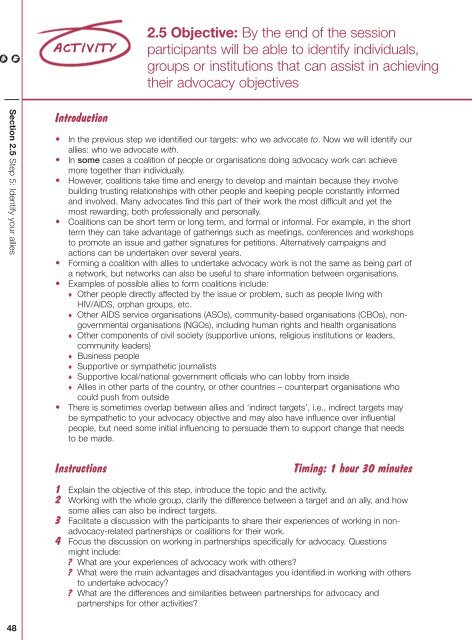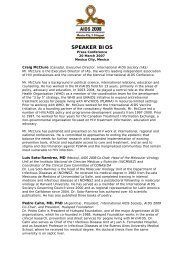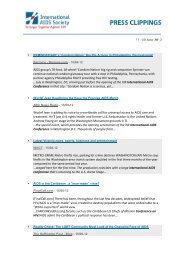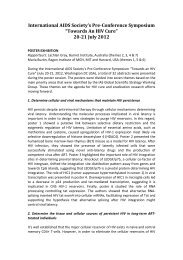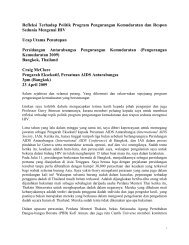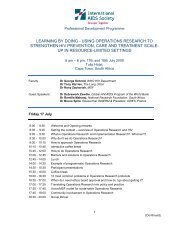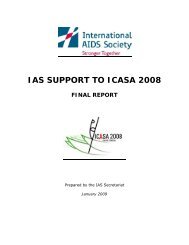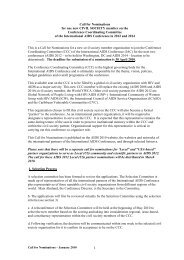Advocacy in Action - International AIDS Society
Advocacy in Action - International AIDS Society
Advocacy in Action - International AIDS Society
Create successful ePaper yourself
Turn your PDF publications into a flip-book with our unique Google optimized e-Paper software.
ACTIVITY<br />
2.5 Objective: By the end of the session<br />
participants will be able to identify <strong>in</strong>dividuals,<br />
groups or <strong>in</strong>stitutions that can assist <strong>in</strong> achiev<strong>in</strong>g<br />
their advocacy objectives<br />
Section 2.5 Step 5: Identify your allies<br />
Introduction<br />
• In the previous step we identified our targets: who we advocate to. Now we will identify our<br />
allies: who we advocate with.<br />
• In some cases a coalition of people or organisations do<strong>in</strong>g advocacy work can achieve<br />
more together than <strong>in</strong>dividually.<br />
• However, coalitions take time and energy to develop and ma<strong>in</strong>ta<strong>in</strong> because they <strong>in</strong>volve<br />
build<strong>in</strong>g trust<strong>in</strong>g relationships with other people and keep<strong>in</strong>g people constantly <strong>in</strong>formed<br />
and <strong>in</strong>volved. Many advocates f<strong>in</strong>d this part of their work the most difficult and yet the<br />
most reward<strong>in</strong>g, both professionally and personally.<br />
• Coalitions can be short term or long term, and formal or <strong>in</strong>formal. For example, <strong>in</strong> the short<br />
term they can take advantage of gather<strong>in</strong>gs such as meet<strong>in</strong>gs, conferences and workshops<br />
to promote an issue and gather signatures for petitions. Alternatively campaigns and<br />
actions can be undertaken over several years.<br />
• Form<strong>in</strong>g a coalition with allies to undertake advocacy work is not the same as be<strong>in</strong>g part of<br />
a network, but networks can also be useful to share <strong>in</strong>formation between organisations.<br />
• Examples of possible allies to form coalitions <strong>in</strong>clude:<br />
♦ Other people directly affected by the issue or problem, such as people liv<strong>in</strong>g with<br />
HIV/<strong>AIDS</strong>, orphan groups, etc.<br />
♦ Other <strong>AIDS</strong> service organisations (ASOs), community-based organisations (CBOs), nongovernmental<br />
organisations (NGOs), <strong>in</strong>clud<strong>in</strong>g human rights and health organisations<br />
♦ Other components of civil society (supportive unions, religious <strong>in</strong>stitutions or leaders,<br />
community leaders)<br />
♦ Bus<strong>in</strong>ess people<br />
♦ Supportive or sympathetic journalists<br />
♦<br />
♦<br />
Supportive local/national government officials who can lobby from <strong>in</strong>side<br />
Allies <strong>in</strong> other parts of the country, or other countries – counterpart organisations who<br />
could push from outside<br />
• There is sometimes overlap between allies and ‘<strong>in</strong>direct targets’, i.e., <strong>in</strong>direct targets may<br />
be sympathetic to your advocacy objective and may also have <strong>in</strong>fluence over <strong>in</strong>fluential<br />
people, but need some <strong>in</strong>itial <strong>in</strong>fluenc<strong>in</strong>g to persuade them to support change that needs<br />
to be made.<br />
Instructions<br />
Tim<strong>in</strong>g: 1 hour 30 m<strong>in</strong>utes<br />
1 Expla<strong>in</strong> the objective of this step, <strong>in</strong>troduce the topic and the activity.<br />
2 Work<strong>in</strong>g with the whole group, clarify the difference between a target and an ally, and how<br />
some allies can also be <strong>in</strong>direct targets.<br />
3 Facilitate a discussion with the participants to share their experiences of work<strong>in</strong>g <strong>in</strong> nonadvocacy-related<br />
partnerships or coalitions for their work.<br />
4 Focus the discussion on work<strong>in</strong>g <strong>in</strong> partnerships specifically for advocacy. Questions<br />
might <strong>in</strong>clude:<br />
? What are your experiences of advocacy work with others?<br />
? What were the ma<strong>in</strong> advantages and disadvantages you identified <strong>in</strong> work<strong>in</strong>g with others<br />
to undertake advocacy?<br />
? What are the differences and similarities between partnerships for advocacy and<br />
partnerships for other activities?<br />
48


